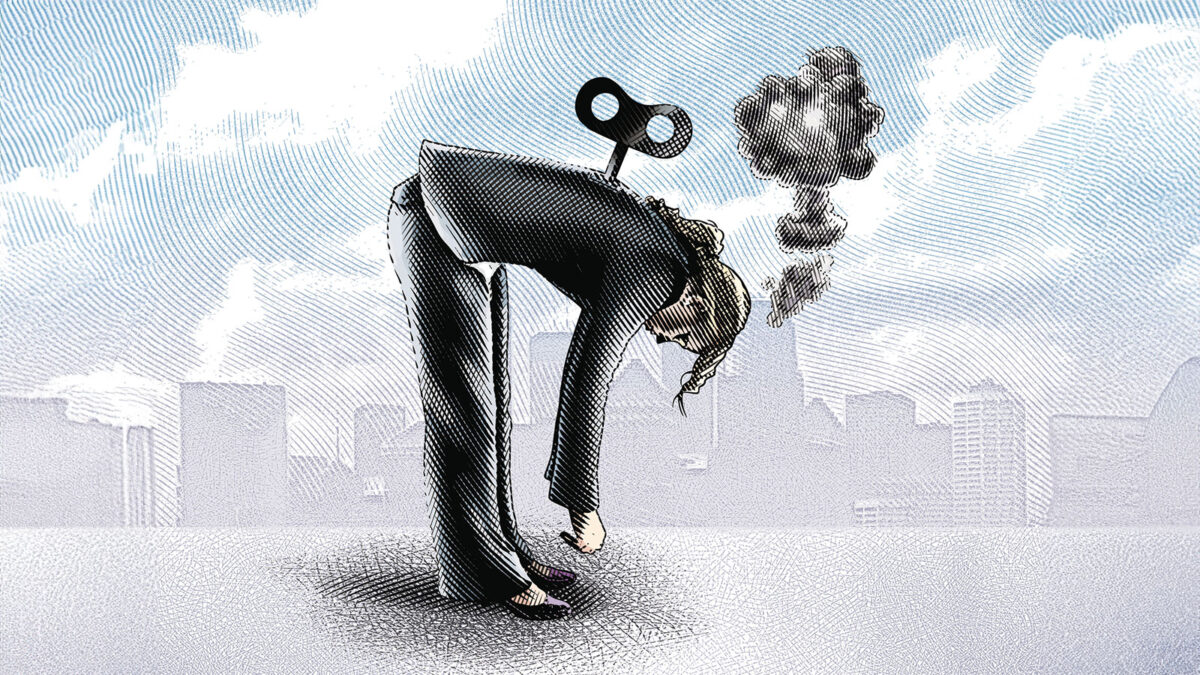
Preventing Lawyer Burnout
January/February 2024
Download This Article (.pdf)
Burnout can sneak into our lives, often without us realizing it until it’s too late. Nobody is immune to burnout, regardless of their profession. This article is about my experience with burnout as a psychologist, and how I got myself back on track. I’ll cover the factors that contribute to lawyer burnout, the warning signs of burnout, and the steps to burnout recovery.
My Encounter With Burnout
I learned firsthand how easily burnout can take hold. It wasn’t until I reached a crisis point that I recognized I was on the brink of burnout. A severe illness in the pre-COVID era left me unable to stand for more than a few minutes without dizziness and plagued by constant aches and pains. Perhaps you can recall a time when you fell seriously ill, confined to your bed for days. Reflecting on your circumstances before getting sick, you might realize that you were pushing yourself to the limit, trying to do too much too quickly. Sickness can serve as a signal from your body, warning you that you’ve been depleting your reserves faster than you can replenish them. Wise individuals heed this message, making necessary lifestyle changes to avoid a repeat occurrence; after all, chronic stress or “overuse” of our stress response directly impacts our immune systems, making us more susceptible to many types of illnesses. But I wasn’t so wise back then.
It wasn’t until I was barely able to get out of bed and struggling to fulfill my basic responsibilities that I realized it was burnout taking its toll. I had been juggling the roles of Super Mom and Wonder Woman, catering to everyone except myself. Ironically, I believed I was taking care of myself because I maintained a rigorous workout regimen alongside my other commitments. But being confined to bed forced me to scrutinize my life and ask the pivotal question, “How did I end up here?”
If you find yourself wondering the same thing, it’s crucial not to place blame on yourself. We take on myriad responsibilities because we believe we must. We convince ourselves that we need to do it all, or else our world will crumble. This subconscious belief obscures the truth: it’s entirely possible to keep our lives running smoothly with some adjustments. With willingness to make changes, you can maintain a well-functioning life while avoiding burnout.
The Threat of Burnout for Lawyers
In the relentless and demanding world of law, attorneys frequently find themselves on the verge of burnout. In a 2021 survey on attorney work satisfaction, lawyers reported experiencing burnout in their jobs 52% of the time.1 This is a pervasive and frequently insidious occupational hazard that poses a serious threat to your health and performance. The legal profession, with its ceaseless deadlines, complex cases, and weighty responsibility of advocating for others, exacts a considerable toll on lawyers’ mental and emotional well-being.2 Lawyers who strive to maintain high standards of legal practice while meeting the expectations of their clients are often stuck in this cycle of stress. According to a 2023 survey, 71.1% of surveyed lawyers reported experiencing anxiety, marking a 5% increase from 2022.3 Additionally, 38.2% acknowledged feeling depressed, up from 35% in 2022.4
Burnout is more than just a feeling of weariness. It’s a complex condition that can appear in a variety of ways, impacting both personal well-being and professional performance. For example, burnout can impact the way you view yourself and the world, make it difficult to work at the same pace as you’re used to, and even impact personal relationships outside the workplace. Lawyers are routinely subjected to chronic stress, lengthy work hours, and the persistent pursuit of billable hours.5 These circumstances can allow burnout to sneak up on you.
Recognizing the Signs of Burnout
The impacts of burnout are varied. You may notice changes to how your body physically feels or operates as well as changes to your mood, emotions, and thoughts. Burnout may even impact how you behave or interact with yourself and others. Consider some of the following common signs of burnout.
Physical Signs
One common physical sign of burnout is chronic exhaustion and feeling tired even after a full night’s sleep. Burnout can also show up as changes in the way you sleep. Lawyers can have trouble sleeping because their minds are racing or sleep too much to escape their daily duties. Frequent headaches or migraines, muscle aches and pains, clenched jaw, or digestive upset are additional physical signs of stress that can indicate you may be headed toward burnout.
Emotional and Cognitive Signs
A strong feeling of cynicism and disconnection is one of the most noticeable cognitive signs of burnout. Lawyers who are experiencing burnout may start to lose interest in their job, clients, and coworkers. They may have cognitive impairments like memory loss and trouble focusing. They may find it difficult to think straight and make good decisions, which could negatively affect their work, potentially causing mistakes and setbacks. An overwhelming sense of worry, restlessness, and being “on edge” are also common experiences when stressed or overwhelmed. The constant demands of legal work and the weight of emotional situations can make these symptoms worse, making it hard to find relief.
Behavioral Signs
One noticeable change in behavior linked to burnout is missing more work. Lawyers who are overly stressed may need time off to recover from illness, to seek treatment, or just to rest. Another change in behavior is a greater pessimism and criticism about things that have to do with work. Lawyers might get down on themselves and complain about their colleagues, clients, or cases, or they might isolate and cease to seek consult and support. These shifts can have the unintentional consequence of impacting the morale of the team and make the workplace even more stressful.
Steps to Recovery From Burnout
Fortunately, there are a series of steps you can take to get organized when burnout feels imminent or has already taken hold. It may seem counterintuitive to stop to engage in organizational tasks when stress levels are high and you’re feeling overwhelmed, but taking the time to reevaluate what’s working and what’s not can put you on the path to setting boundaries and lowering your stress levels.
Step 1. Inventory Your Responsibilities
The first step is to write down everything you do, personally and professionally, to keep things running smoothly. Be as comprehensive and as detailed as you can, because this is where the possibilities for change lie.
Step 2. List Your Late-Night Worries
Step 2 is to create a list of your worries—the issues that keep you awake at night. Sometimes, we use worrying as a motivator to keep ourselves going and stay on top of our responsibilities. The fear of forgetting something can keep us up at night. Even if we’ve remembered everything, the anxiety of not doing enough can be equally paralyzing. Worry is a major contributor to burnout, and because we might feel like worrying helps us, it keeps us from recognizing that we may be nearing burnout.
Step 3. Categorize Your Responsibilities
With your lists of responsibilities and worries in hand, it’s time to peel away the veil that blinds us to the belief that life must be this way. Step 3 is to take an objective look at your list of responsibilities and determine which can be delegated, which can be deleted, and which must be carried out by you alone. Use three different colors to highlight these responsibilities:
- Use one color to denote tasks that someone else could take on. It doesn’t matter whether it makes you uncomfortable to ask for assistance or you believe no one can do it as well as you can—these are the tasks that can be outsourced.
- Use the second color for responsibilities that can be eliminated with minimal disruption to your life.
- Use the third color for those responsibilities that only you can do, or that you undertake by choice rather than necessity. This list should be the shortest. Viewed objectively, very few tasks can only be done by you and no one else.
Step 4. Consider the Worst-Case Scenarios
The last step is to examine your list of worries and write out the worst-case scenarios for each one. It’s often the worst-case scenarios that truly plague our thoughts. What if your fears came true? What would be the consequences? It’s crucial to put these concerns down on paper, particularly when it comes to your worries. There’s a big difference between having something behind your eyes and having it in front of your eyes. Afterward, search for ways to mitigate these worst-case scenarios, or consider what you would do if worst-case scenarios do come to pass. Creating safety nets such as asking for assistance from colleagues or loved ones, or seeking professional coaching or mental health support, can help alleviate your worries and prevent them from driving you to burnout.
Systemic Origins and Consequences of Burnout in the Legal Field
The risk of burnout is ever-present in the legal field, with systemic and organizational issues helping perpetuate this cycle. It’s evident that the issue of burnout is closely tied to the workplace and often pervasive within legal culture rather than stemming from the individual attorney alone.6 Burnout prevention serves as a vital call to action, urging legal professionals and organizations to adopt a more supportive approach to their careers and the practice of law. It’s crucial to implement strategies that address and diminish the risks associated with burnout. Failure to recognize these risks and implement effective practices could significantly impact the practice of law. This is vital not only for the well-being of attorneys but also for maintaining the quality and integrity of legal services provided to clients, and for the overall success of the legal practice.
I’ve learned my lesson. Will you?
Related Topics
Notes
1. American Bar Association, “Surveyed Lawyers Report They Experience Burnout In Their Jobs More Than Half The Time,” ABA J. (Mar. 2022), https://www.americanbar.org/groups/journal/articles/2022/surveyed-lawyers-report-they-experience-burnout-in-their-jobs-mo/#:~:text=Surveyed%20lawyers%20said%20they%20experienced,2020%2C%20according%20to%20the%20publication.
2. Krill et al., “The Prevalence of Substance Use and Other Mental Health Concerns Among American Attorneys,” 10(1) J. Addict Med. 46–52 (Jan.–Feb. 2016).
3. Roe, “Why is Mental Health in the Legal Profession Getting Worse,” Law.com (May 2023), https://www.law.com/americanlawyer/2023/05/18/theres-a-lot-of-backlog-to-address-why-mental-health-in-the-legal-profession-is-getting-worse/?slreturn=20230927114001#:~:text=In%20this%20year’s%20survey%2C%2071.1,2023%20from%2014.6%25%20in%202022.
4. Id.
5. Geist, “8 Warning Signs of Lawyer Burnout and What to Do About It,” One Legal blog (Sept. 2023), https://www.onelegal.com/blog/lawyer-burnout.
6. Moss, “Burnout Is About Your Workplace, Not Your People,” Harv. Bus. Rev. (Dec. 2019), https://hbr.org/2019/12/burnout-is-about-your-workplace-not-your-people.
In the relentless and demanding world of law, attorneys frequently find themselves on the verge of burnout. In a 2021 survey on attorney work satisfaction, lawyers reported experiencing burnout in their jobs 52% of the time.


